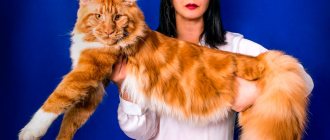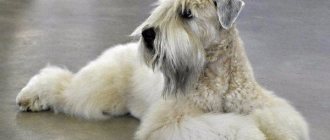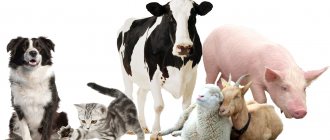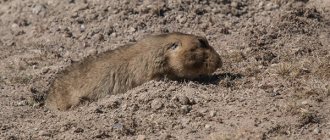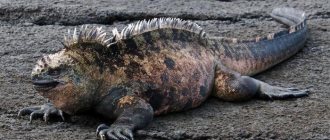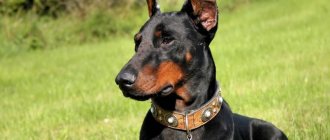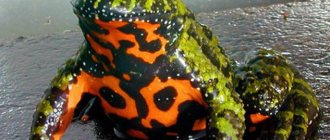Victor Sergin “Nature” No. 11, 2019
about the authorViktor Yakovlevich Sergin - Doctor of Historical Sciences, leading researcher at the Institute of Archeology of the Russian Academy of Sciences. Area of scientific interests: settlements of the Paleolithic era, the relationship between man and the natural environment. |
How did a person acquire a loyal friend and helper? According to a popular belief, in ancient times, in conditions of competition, packs of the least timid wolves gradually switched to feeding on garbage near human dwellings. Predators interested in a convenient niche became less dangerous to people. Friendly individuals came into contact with people. Sometimes people took puppies, and the wolf cubs that grew up among people considered them members of their pack. The connections were strengthened, and after some time the selection of more accommodating individuals could already occur.
One of the weaknesses of the existing ideas about the domestication of the wolf is the lack of certainty regarding the time and place of the process. And these characteristics were not formal coordinates.
Where did dogs come from?
There are still two theories about the origin of these animals. According to the first monophyletic, these animals have only one ancestor in their genus. For a long time it was believed that the ancestor of the modern dog was the gray wolf, because it is not without reason that many breeds of domestic animals are similar in appearance to this predator.
The wolf is a relative of modern dogs
However, over the past few years this theory has been successfully refuted. The central arguments are:
- molecular DNA analysis of the remains of ancient dogs and wolves indicates a great disunity in genetics between these animals;
- the skulls of these animals found during excavations are not similar to each other;
- All experiments carried out on crossing these two animals did not give the required result. The hatched specimens continued to be aggressive;
- experiments to domesticate the wolf have so far ended unsuccessfully. It turned out to be impossible to overcome the natural caution of the predator;
- The physiological characteristics of a wolf are superior to those of a dog.
For your information! Most scientists are of the opinion that the dog comes from jackals. It is they, and not wolves, who can approach villages where people live, and in difficult times they can feed on waste, unlike gray predators who, out of hunger, are ready to attack prey rather than pick up food.
According to the second polyphyletic theory, the origin of dogs goes back not to just one historical root, but to several. The following arguments are given to prove this:
- in different areas of the earth, fragments of skeletons of prehistoric dogs from the same period of existence, but different in body structure, size and other physiological characteristics, are found;
- Scientists have repeatedly experimented with crossing dogs of different breeds, but as a result they received specimens that were similar to each other. The conclusion suggests itself that if there had been a single ancestor, modern dogs would not differ much from each other;
- The outstanding Austrian zoologist and zoopsychologist K. Laurens developed his theory of the origin of dogs. According to her, these domestic animals have jackal-wolf heredity, but in different proportions. The temperament of the beast depends on the predominance of one blood or another.
Other hypotheses
The fish birth hypothesis is supported by the fact that early in life the human embryo resembles a fish.
He has:
- resemblance to a fish brain;
- gill sacs on the neck;
- limb buds resembling fins;
- tail, heart and kidneys, like a fish.
The second incredible assumption is that life on Earth was created by aliens from outer space. Probably, such thoughts come to every tourist visiting the Egyptian pyramids in the Giza Valley on the outskirts of Cairo. Most likely, this opinion is due to the influence of ancient remnants in the minds of people, with the preservation of a naive belief in the omnipotence of cosmic forces.
Darwin's research
Where did cats come from and who did they come from?
The world-famous scientist Charles Darwin, who devoted his life to questions of origin and natural selection, in 1859, in his book “The Origin of Species,” outlined his theory of where modern dogs came from. Traveling a lot, he noticed that man’s four-legged friend looked like a wild animal living in the area. So, in one territory a domestic dog looks similar to the foxes living there, in another - like coyotes, in a third - like wolves.
Possible ancestors
Important! But to be based only on Darwin's research today is irrational. After all, the scientist could not know much, since at that time systematics and history were not sufficiently developed to draw meaningful conclusions.
Scientists all over the world and at all times have sought to answer the question of where dogs came from and have expressed many theories. However, the question of how dogs appeared has not yet been fully studied. And the final point in these studies has not been set.
Evolution of mammals
The origin of this class of animals goes back to the Carboniferous period. At this time, the amniotes, vertebrates that laid eggs in a hard shell, diverged.
Amniotes were distinguished from amphibians primarily by this feature: they did not require water to reproduce; the egg contained the necessary supply of nutrients for the growth of the embryo. Thus, amniotes colonized land areas relatively far from water bodies, which means they received a number of evolutionary advantages.
Among this group, synapsids began to stand out, a characteristic feature of which was the specialization of teeth and structural features of the lower jaw. This was an important nutritional advantage, allowing them to expand their diet in any habitat. Also, paleontologists in recent reports suggest that the skin of synapsids did not have scales, but was equipped with glands: this helped regulate heat transfer and fluid levels in the body. Synapsids were the ancestors of mammals.
The periodization of the evolution of mammals includes the following periods:
- Isolation of the synapsid group from amniotes in the Carboniferous period.
- Isolation of therapsids.
- Evolution of cynodonts from the Permian to the Triassic period.
- The development of the class of mammals and their occupation of ecological niches left by extinct dinosaurs.
Dental Specialization
Heterodontism provided an important evolutionary advantage to the ancestors of mammals. It represents the division of teeth according to shape and function.
Mammalian teeth are divided into three types: incisors, canines and molars. By the degree of development of certain types of teeth, one can judge how a particular species of animal feeds. Thus, predators have the most developed teeth - canines, and rodents - incisors. Ruminants have well-developed molars, which allow them to grind plant foods with a large amount of fiber. The picture shows human teeth: incisors (I), canines (C), premolars (B), molars (M).
At the same time, in some mammals the teeth may be reduced. Sometimes this happens to all teeth, sometimes only to one type. In some cases, some species even have secondary homodontism; this feature is characteristic of whales. Characteristics of the dental formula are one of the determinants of the species.
Homeothermy
The ancestors of mammals developed true warm-bloodedness. Its formation was facilitated by such distinctive features as the structure of the skin and the ability to maintain a high metabolism through nutrition.
By the Permian period, to maintain warm-bloodedness in therapsids - one of the groups of synapsids - the following mechanisms appeared:
- division of the heart into four chambers, which allows arterial and venous blood not to mix, so oxygen is consumed more efficiently;
- the formation of a bony palate, which finally separates breathing and digestion; the animal can breathe while eating.
The latter became part of the modification of the entire jaw system. The chewing muscles developed, the structure of the jaw joint changed, and auditory ossicles were formed from part of the lower jaw bone, on the basis of which the auditory analyzer - the ear - would later be formed.
Mammalization
The skin is one of the means of thermoregulation of the body. It performs this function thanks to sweat glands, which remove excess heat in the form of liquid (sweat), as well as the presence of wool - it helps to retain heat at low temperatures.
Whether hypertooths had fur is a controversial issue, but the presence of sweat glands is a fact. From some of them, modern mammary glands gradually emerged. Initially, their role in feeding the offspring was modest: the cub may have compensated for the lack of water and mineral salts by licking liquid.
A developed mammary gland is still not characteristic of all mammals. Thus, monotremes (in school textbooks they are called oviparous, as opposed to viviparous), currently represented by the platypus and echidna, do not have nipples, and the baby licks the secreted milk. The nipple appeared later in another branch of mammals.
The mammary glands are not located just anywhere, but along the so-called milk lines running from the groin to the armpits.
Early period of domestication
Dog Milo (breed like in the Mask): history and description
The question of dog domestication is also an interesting one. It is believed that this process began to occur more than 15-30 thousand years ago. The process of domestication first began to appear in one area, presumably in the European part, and then spread to the rest of the territory.
Note! Australia is an exception in this regard. A domesticated dog was already brought there, which eventually went wild and became the progenitor of the modern dingo dog.
There are also two training scenarios. According to the first, man domesticated the animal, and according to the second, his ancestor himself joined people, self-domestication occurred. Moreover, each territory had its own domestication scenario and for its own purposes.
According to archaeological research, the domestication of the dog occurred even at a time when people did not lead a sedentary lifestyle and did not engage in agriculture and cattle breeding, but obtained their own food by hunting. Initially, the skins of dogs' ancestors were used as clothing and bedding, and they themselves could be eaten. Later they noticed that they are excellent hunting assistants, and began to use them in this capacity. It was also noticed that animals are able to defend and protect their habitat from encroachment. With the development of cattle breeding, four-legged animals became indispensable assistants in this matter. Their tasks were to protect the herd from scattering over vast territories and to protect them from attacks by predators. For such purposes, stronger, tougher and more vicious individuals were selected.
For your information! Presumably, at the same time they began to use domesticated animals for military purposes.
Adherents of the self-domestication point of view believe that the ancestors of dogs, who for some reason strayed from their pack, moved closer to humans in the hope of being able to eat leftover food. In addition, the ancestors, having killed the mother of the predator, could take the cubs to themselves. Growing up, they were no longer in a hurry to leave the territory of the settlement and remained to live next to people.
Animal domestication
Palaeozoic
Paleozoic Era The Paleozoic era includes six periods.
The Cambrian period (530 - 490 million years ago) is characterized by the emergence of representatives of all species of plants and animals. The oceans were inhabited by algae, arthropods, and mollusks, and the first chordates (haikouihthys) appeared. The land remained uninhabited. The temperature remained high.
Ordovician period (490 - 442 million years ago). The first settlements of lichens appeared on land, and megalograptus (a representative of arthropods) began to come ashore to lay eggs. In the depths of the ocean, vertebrates, corals, and sponges continue to develop.
Silurian period (442 – 418 million years ago). Plants come to land, and the rudiments of lung tissue form in arthropods. The formation of the bone skeleton in vertebrates is completed, and sensory organs appear. Mountain building is underway and different climatic zones are being formed.
Devonian period (418 - 353 million years ago). The formation of the first forests, mainly ferns, is characteristic. Bone and cartilaginous organisms appear in reservoirs, amphibians began to come to land, and new organisms—insects—are formed.
Carboniferous period (353 – 290 million years ago). The appearance of amphibians, the subsidence of the continents, at the end of the period there was a significant cooling, which led to the extinction of many species.
Permian period (290 - 248 million years ago). The earth is inhabited by reptiles; therapsids, the ancestors of mammals, appeared. The hot climate led to the formation of deserts, where only hardy ferns and some conifers could survive.
How people domesticated the dog
The dog became the first animal to be domesticated by man. The time of domestication is also not precisely known. Some scientists talk about 10-14 thousand years ago, others refer to dates of 30-25 thousand years ago.
Chihuahua: breed history and origin
Most likely, the process of domestication occurred by luring the animal with the smell of food. They came again and again. People have learned to benefit from this. They took young puppies and raised them, trying to rid them of aggression. After a long time, people began to breed new breeds of dogs in this way. They were adapted for various purposes.
For your information! According to the Fédération Cynologique Internationale, there are currently about 500 types of pedigree dogs.
In general, the “man-dog” union was mutually beneficial. For people, an animal is an assistant in hunting and protecting their home and property; for an animal, a person is a stronger and more dexterous provider with whom they can go hunting for large animals, as well as the opportunity to obtain food and shelter.
Group, its composition and method
The international nature of the research confirms the international nature of its participants. Peter Slavolainen represents the Royal Institute of Technology "KTH", and in addition to him, Ya-Ping Zhang from the Institute of Zoology (Kunming) and scientists from many other countries work on it. They carefully analyzed and sequenced the genomes of 58 representatives of the Canidae family, including ten wolves, 23 dogs from East Asia (northern and southern regions), four country dogs from Nigeria and 19 different breeds from around the world, including Afghan hounds, Siberian huskies and Alaskan dogs. Malamutes, Chihuahuas, Peruvian Hairless Dogs, Tibetan Mastiffs, and some North African subspecies.
Prevalence in the world
A certain number of dogs are registered in a given country.
In Russia
According to statistics from the end of 2022, over the past few years the number of domestic dogs in the country has increased by more than 1.5 million individuals and amounts to about 19 million animals. Russia ranks 5th in terms of the number of dogs in a household. It is believed that recently Russians have become more responsible in relation to their pets in terms of treatment and feeding.
Note! The most popular classification of decorative dog breeds for keeping a home is Yorkie, Chihuahua, Spitz, and Dachshund.
In Iran
In a Muslim country, dogs are viewed negatively as pets. Walking dogs in public places and transporting them on public transport is not allowed there; advertising of products for four-legged animals is prohibited. Such injustice to four-legged animals is associated with religious beliefs: for Muslims, a dog, like a pig, is considered a dirty animal. However, over the past 15-20 years, representatives of the middle class began to break this tradition, and having a dog at home already denoted some status. According to unofficial data, several thousand domestic dogs live in Tehran. More often they prefer to have small dogs, Spitz dogs or Yorkshire terriers.
In Japan
In the Land of the Rising Sun, dogs are treated the same as children. It is impossible to meet a stray dog here. All animals are microchipped and are monitored by veterinary organizations. However, this country has introduced a ban on dogs living in an apartment building. Yes, and you can walk animals only in strictly defined places. And yet the love for man’s four-legged friends does not decrease among the inhabitants of Japan. They create all possible benefits for their pets and try to provide them with a comfortable life.
For your information! The most popular Asian dog breeds in the country, preferably local ones: Akita Inu, Shiba Inu, Kishu Inu.
IN THE USA
According to statistics, over the past ten years the number of pet dogs in the states has increased to 80 million individuals, which is more than 65% of the total number of American families. In fact, not everyone can have a four-legged one. The reason for this is the high cost of veterinary services. In addition, when renting an apartment, permission to keep a dog will have to be obtained from the owner of the property. And, if he allows it, then it will be necessary to make an additional payment for future replacement of furniture and carpeting. Registration of animals is also required, which will also cost a considerable amount. With this approach, it is clear that hardly anyone will decide to adopt an animal without thinking about the costs. Popular breeds in the states are Labrador Retriever, German Shepherd, Golden Retriever.
In China
Until the 90s. last century, China introduced a ban on dogs as pets. However, since 1994 this law has been repealed, but with some restrictions. Thus, it is still prohibited to own large breed dogs. In addition, owning a dog is an indicator of high status. This is due to increased taxes for pet owners. But, despite these restrictions, just 10 years after the law was repealed, the number of four-legged animals exceeded 27 million individuals throughout the country. The three most popular breeds in the Middle Kingdom are the Siberian Husky, Labrador, and Golden Retriever.
Variety of breeds
Four-legged friends have been playing an important role in the life of mankind for quite a long time. It is not for nothing that there is an already established phraseology “A dog is a man’s friend.” And, even though it is not known for certain from whom dogs originated, we can say with confidence that in the course of evolution the most successful specimens were obtained, which became the ancestors of modern dogs.
Dog's fidelity
- A dog will never betray you and will be a loyal friend to the end.
- Her devotion knows no bounds.
- Will give his life for the owner, sacrificing himself.
Many people think it's instinct. The ancient dog lived in a pack and obeyed the leader. Now she chooses the owner and also obeys.
But that's not true. Not every dog and not every owner will sacrifice itself. A dog will give his life for the one he loves.
- Even during excavations in Pompeii, they found the skeleton of a dog on the skeleton of a child - the dog was covering it with itself.
- Pit bull Zeus saved children from a poisonous snake at the cost of his life.
- The little dog Siko almost lost her eye while protecting her owner’s daughter from a snake.
- Another dog threw himself under the wheels of a motorcycle and saved the owner’s daughter, receiving severe injuries.
The man's friends were not protecting their owner! So what does instinct have to do with it?
- Pitbull Lefty from Virginia protected his owner from bullets that burst into the house of bandits.
- Briton Graham Nuttell died on a mountain walk while walking his four-legged friend. A quarter of a year later, quite by accident, his body was discovered in the mountains. His faithful friend lay nearby, dying of hunger. But he didn’t leave. He died almost immediately after the body of his beloved owner was interred. In honor of the devoted Rusvarp, a monument was even erected in this settlement.
- In the thirties of the last century, people noticed a dog that was sitting near the entrance to the hospital, waiting for its owner. But, unfortunately, the farmer, her owner, died. His body was sent by train to the place where he was from. His faithful dog accompanied him on his last journey. But he did not think that the owner would not return.
He continued to wait for five whole years without losing hope. During this time, old age came to him, and with it deafness, which became the cause of his death. The dog was hit by a train. Local residents perpetuated the memory of man's faithful friend by erecting a bronze monument to the dog Shepa.
- Rottweiler Yves pulled his owner out of a burning car. Blind, deaf, and even on three legs, the dog Tru saved his owner and her little son during a fire.
- At the funeral of his owner, a dead Marine, the Labrador Hokie lay down next to the coffin and did not want to leave. This photo, posted on social networks, spread around the world.
- When the Chinese villager Lao Pan died, his faithful friend did not want to leave the burial place of his master. Kind people built a dog house-kennel for her. They came to feed the dog. She died right at the grave, without leaving her owner a single step.
- In Edinburgh, right in front of the entrance, Bobby the dog was buried next to his owner. When his owner died, the dog came to the grave and remained to live in the cemetery, living there for the rest of his life, which was almost fourteen years. At the time of the owner's death, the dog was only 2 years old. People dedicated a memorial inscription to Bobby on his grave, which spoke of the loyalty and devotion of man's friend, which should be a lesson to us people.
Opinion of modern scientists
Today, researchers are looking more broadly, but also more cautiously, at the question of the origin of the dog. Thus, more and more often, works began to appear in the scientific press indicating that a wolf and a dog are not ancestors and descendants at all, but, to be more precise, “cousins.” It was discovered that they separated from a common ancestor in the range of 11-34 thousand years ago. This particular theory is being developed by scientist Adam Friedman and his associates from the Chicago Laboratory.
To reach these conclusions, experts examined the genomes of a number of dog breeds from areas where wolves do not live today. Wolves were genetically studied from those that live in places where the domestication of dogs supposedly began. Common jackals were taken as an outgroup (this means a species close to the one being studied).
Genetic analyses, a complex scheme and comparison of all groups according to a line of single-nucleotide mutations led to the construction of a system of kinship between dogs and wolves. And it turned out that absolutely all dogs are genetically close, and wolves, it must be said, created a separate cluster.
Thus, experts suggested that at a certain historical moment (exactly when is unknown), wolves and dogs became detached from a common ancestor, but did not lose the ability to interbreed with each other. And these crossings probably led scientists to a false idea, because initially geneticists decided that wolf genes in a dog are evidence of the formation of a dog from a wolf. Californian scientists, who also conducted a study on the same topic, agreed with their Chicago colleagues. Thus, today the opinion of the scientific community, although sometimes divided, tends to be that dogs and wolves are not direct relatives.
Homeland of the dachshund
Since the skeletons of the prototypes of the modern dachshund were discovered on the territory of present-day Germany back in the 2nd century BC. e., then this country is considered the birthplace of the dog. Documents from the 7th century mention a beaver dog, which was used to hunt otters, beavers, badgers, and was used in baiting foxes and hares. In the 15th century, a breed was described that looked like modern taxis. Their rapid spread and breeding began in the era of late feudalism, when cities grew rapidly and a new class of burghers appeared. It was they who made the breed popular, telling entertaining stories about hunting with it, ease of keeping, and ability to hunt any animal and bird. By the name of the pet, one can judge its use - badger, earthen, creeping, crawling into holes.
Throughout the 17th century, the breed was developed, new colors were introduced, and efforts were made to improve it. Not only hunters, but also ordinary lovers became interested in dogs. New species were created - with long and short hair. In 1880, a unified breed standard was adopted and the first German pedigree book was approved. Another 8 years later, a Tekel club was opened in Berlin (Teckel was the name for dachshund in northern Germany). At the end of the 19th - beginning of the 20th centuries in Germany, an attempt was made to breed dachshunds that differ in height and weight in order to be able to use the dog in different conditions and for any animal.
The maximum popularity of the breed occurred at the beginning of the 20th century, when the passion for taxis crossed the borders of Germany and conquered the whole of Europe. They were bought not only as hunting dogs, but also for the home, as decorative ones. For many years, dogs were considered a symbol of comfort and respectability. In Germany, dachshunds are the national breed. On the territory of the country there is a village called Gergveis, where dachshunds live in every house. The place is called the “capital of dachshunds”; people come here for puppies from all parts of the world. The popularity of the breed in Germany is so enormous that the dachshund became the symbol of the Munich Olympic Games. Since the dog has changed over several centuries thanks to selection work carried out by German dog handlers, we can say that the dachshund is a breed bred in Germany. In the 19th century, it was improved in England, Austria and Sweden. At the end of the 19th century, dogs were brought to the USA, a club was organized, but in America they are rarely used for hunting, preferring to be considered as sport.
Evolutionary theory
The two main theories of the origin of dogs include monophyletic and polyphyletic. The first means that the animal came from one ancestor, while the second suggests that the dog’s ancestors were different animals. Researchers who are supporters of monophyly are confident that the wild wolf is the ancestor of the dog. The skull and external features of a wolf are indeed similar to a dog, and the process of domestication has changed the cranial bones of the animal.
According to the evolutionary hypothesis, domestication occurred in a specific place, and only then dogs began to spread throughout the Earth . True, even supporters of monophyly do not agree that the wolf is the “great-grandfather” of the dog - some scientists are sure that dogs originated from the coyote or jackal.
Be that as it may, the dog is considered the first domesticated animal. Archaeological excavations have made it clear that this happened back in the Stone Age, when people had not yet taken up farming and raising livestock, but wild animals were hunted. In 1862, researchers found the remains of a dog on Swiss lakes; they were attributed to the Neolithic period. It was a small animal, it was called a peat (or swamp) dog.
It is believed that human evolution required evolutionary development from domesticated animals. As soon as our ancestors began to lead a sedentary lifestyle, as soon as they began to engage in agriculture and cattle breeding, the requirements for a domesticated dog increased. And this was the first impetus for the breeding of breeds.
It should be said that one of the first serious works on the origin of the dog belongs to the pen of the famous scientist Konrad Lorenz. The scientist assumed that man initially attracted the jackal to serve himself - the jackal began to inform man about the approach of larger predators.
If you read Lorenz’s monograph, you can conclude: all dogs originated from the wolf and the jackal, and there are “jackal” breeds, and there are “wolf” breeds . And this no longer fits into the concept of the monophyletic theory.
Description of the breed
It is easy to recognize a pug among other four-legged animals thanks to its striking characteristic features:
- stocky body, small stature. These dogs have a “square” body with developed and strong muscles;
- the shape of the head resembles a large apple or a tightly clenched fist;
- big brown eyes. Pugs always have a smart and slightly sad look;
- tail in a “ring”, which is set high and tightly;
- wrinkled muzzle. The most wrinkles are on the forehead;
- short shiny coat.
The pet's character is calm, balanced and sensitive. The dog is not characterized by sudden mood swings and aggression. And what is also noteworthy is that pugs are monogamous. They quickly adapt and adapt to the rhythm and living conditions of their owner. In a word, this is a real Chinese sage.
The dog comes in four colors: beige, apricot, black and silver. And the names of the last three are translated as “warmth of the sun,” “blackness of the night,” and “brilliance of the moon.”

